Total magnification - Study guides, Class notes & Summaries
Looking for the best study guides, study notes and summaries about Total magnification? On this page you'll find 1354 study documents about Total magnification.
Page 4 out of 1.354 results
Sort by
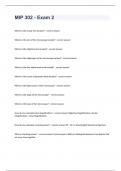
-
MIP 302 Study Guide Exam And Actual Answers 2024.
- Exam (elaborations) • 28 pages • 2024
- Available in package deal
-
- $9.99
- + learn more
Where is the ocular lens located? - correct answer Where is the arm of the microscope located? - correct answer Where is the objective lens located? - correct answer Where is the diaphragm of the microscope located? - correct answer Where is the fine adjustment knob located? - correct answer Where is the coarse adjustment knob located? - correct answer Where is the light source of the microscope? - correct answer Where is the stage of the microscope? - correct answer ...
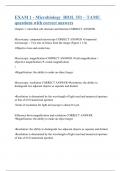
-
EXAM 1 - Microbiology BIOL 351 – TAMU questions with correct answers
- Exam (elaborations) • 52 pages • 2023
- Available in package deal
-
- $14.99
- + learn more
Chapter 1: microbial cell structure and function CORRECT ANSWER Microscopy: compound microscope CORRECT ANSWER •Compound microscope -- Two sets of lenses form the image (Figure 1.15a) •Objective lens and ocular lens Microscopy: magnification CORRECT ANSWER •Total magnification = objective magnification ocular magnification • •Magnification: the ability to make an object larger Microscopy: resolution CORRECT ANSWER •Resolution: the ability to distinguish two adjacent obj...
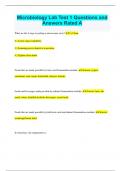
-
Microbiology Lab Test 1 Questions and Answers Rated A
- Exam (elaborations) • 23 pages • 2024
- Available in package deal
-
- $9.99
- + learn more
Microbiology Lab Test 1 Questions and Answers Rated A What are the 4 steps to putting a microscope away? 1.) Clean 2.) Lower stage completely 3.) Scanning power objective in position 4.) Tighten silver knob Foods that are made possible by lactic acid fermentation include: Answer: yogurt, sauerkraut, sour cream, buttermilk, cheeses, kimchi. Foods and beverages made possible by ethanol fermentation include: Answer: beer, ale, mead, wines, distilled alcoholic beverages, yeast bread. Foods that a...
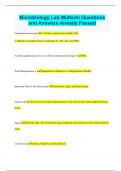
-
Microbiology Lab Midterm Questions and Answers Already Passed
- Exam (elaborations) • 23 pages • 2024
- Available in package deal
-
- $9.99
- + learn more
Microbiology Lab Midterm Questions and Answers Already Passed Compound microscope 1. Ocular-eyepiece lens (usually 10x) 2. Objective-nosepiece lenses (commonly 4x, 10x, 45x, and 100x) At what magnification do you use the oil immersion technique? 100x. Total Magnification = Magnification (Objective) x Magnification (Ocular) Important Parts of the Microscope Framework, Stage, and Lens System Framework Arm and base are the structural parts of the microscope which support the basic frame. Stage...
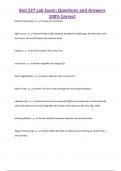
-
Biol 227 Lab Exam; Questions and Answers 100% Correct
- Exam (elaborations) • 29 pages • 2024
- Available in package deal
-
- $12.99
- + learn more
Biol 227 Lab Exam; Questions and Answers 100% Correct body of microscope Answer-arm and base light source Answer-Projects light upwards through the diaphragm, the specimen, and the lenses. Has on/off switch and intensity knob eyepiece Answer-Contains the ocular lens ocular lens Answer-magnifies the image 10x total magnification Answer-objective lens x ocular lens field of view Answer-The area visible through the microscope eyepiece
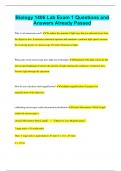
-
Biology 1406 Lab Exam 1 Questions and Answers Already Passed
- Exam (elaborations) • 11 pages • 2024
-
- $9.49
- + learn more
Why is oil immersion used? To reduce the amount of light rays that are refracted away from the objective lens. It increases numerical aperture and maintains a uniform light speed. increase the resolving power of a microscope. Prevents refraction of light. What parts of the microscope does light travel through? Illuminator-The light source for the microscope.Diaphragm-Controls the amount of light entering the condenser. Condenser lensFocuses light through the specimen. How do you calculate t...

-
Bio 227 Lab Exam 1; Questions and Answers 100% Correct
- Exam (elaborations) • 19 pages • 2024
- Available in package deal
-
- $13.99
- + learn more
Bio 227 Lab Exam 1; Questions and Answers 100% Correct total magnification Answer-ocular lens x objective lens Proximal Answer-Nearer to the trunk of the body Distal Answer-Farther from the trunk of the body Anterior Answer-front of the body Posterior Answer-back of the body Lateral Answer-away from the midline
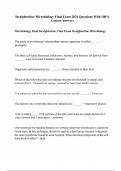
-
Straighterline Microbiology Final Exam 2024 Questions With 100% Correct Answers
- Exam (elaborations) • 35 pages • 2024
- Available in package deal
-
- $15.00
- + learn more
The study of evolutionary relationships among organisms is called ______. - phylogeny The three cell types discussed, eukaryotes, archaea, and bacteria, all derived from ______. - Last Universal Common Ancestor Organisms called parasites are ______. - always harmful to their host Which of the following does not indicate microbe involvement in energy and nutrient flow? - Thermal hot springs warmed by heat from earth's interior The subatomic particles that surround the nucleus are the ______....
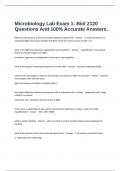
-
Microbiology Lab Exam 1- Biol 2120 Questions And 100% Accurate Answers.
- Exam (elaborations) • 16 pages • 2024
-
- $9.99
- + learn more
What was the purpose of this microscope laboratory experiment? - Answer to name the parts of a compound light microscope and their functions, learn the correct way to use the c.l.m what is the difference between magnification and resolution? - Answer magnification: uses special lenses to enlarge image of an object. resolution: separates or distinguishes structures to close together what is the purpose of placing immersion oil on the slide? - Answer prevents scattering of light ...
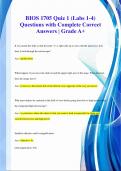
-
BIOS 1705 Quiz 1 (Labs 1-4) Questions with Complete Correct Answers | Grade A+
- Exam (elaborations) • 16 pages • 2024
- Available in package deal
-
- $12.99
- + learn more
If you mount the slide so that the letter "e" is right side up as seen with the naked eye, how does it look through the microscope? Ans: upside down What happens if you move the slide toward the upper right area of the stage. What direction does the image move? Ans: it moves to the bottom left of the field of view (opposite of the way you move) Why must objects be centered in the field of view before going from low to high power using the compound light microscope? Ans: so you know ...

$6.50 for your textbook summary multiplied by 100 fellow students... Do the math: that's a lot of money! Don't be a thief of your own wallet and start uploading yours now. Discover all about earning on Stuvia


